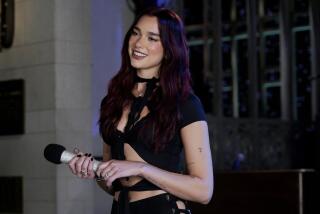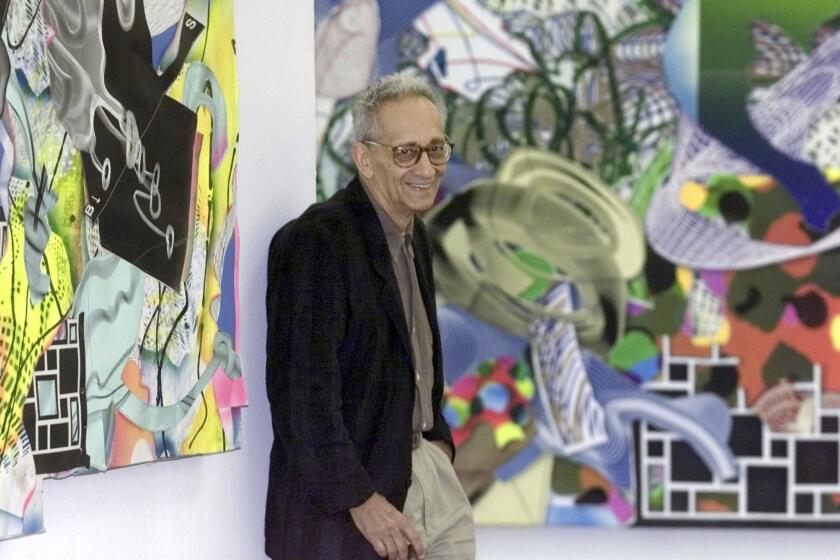The Wesselmann season
Twenty years ago, Tom Wesselmann would not have gotten away with making the paintings for which he’s best known: crisp images of nude women, their nipples and lips silhouetted against wildly decorated bedrooms. Most appeared to have had their eyes and noses erased, making their faces fleshy blanks.
Twenty years before that, when Wesselmann made his series of “Great American Nude” paintings, times were different. The art world was smaller, less linked to the business of entertainment and not so closely tied to educational institutions. It wasn’t run by sharkish bureaucrats or prudish moralists. Artists did what they wanted, often with reckless abandon. If their works didn’t satisfy them and their peers, they moved on to the next thing.
If the 73-year-old Wesselmann were just starting out today, his signature works would fit right in with much of the best stuff coming out of young artists’ studios. These painters and sculptors are more sophisticated (and open-minded) than those of the generation that preceded them. Pleasure plays a far more important role in their work, and beauty is no longer something to be sniffed at, a frivolous distraction or a sure sign of conservatism. Wesselmann has been around so long that the response to his work has come full circle.
At Cal State Long Beach’s University Art Museum, a terrific 40-year survey of Wesselmann’s page-size studies and miniature maquettes (none bigger than a stereo’s bookshelf speaker) playfully traces his up-and-down career. When Wesselmann got started, after moving from Cincinnati to New York in 1956, he humbly assumed that his small-scale works stood on their own and that he’d never make anything bigger. He was half right.
The first four in this efficient, chronological exhibition are the only ones that are not swiftly sketched studies or fully evolved models for larger pieces. They’re masterpieces, no less potent for being served up by the ounce rather than by the gallon.
“Little Great American Nude #1” (1961) is a meticulously observed drawing on a red, white and blue collage made of cardboard, fabric and a postcard picture of skyscrapers. It shows Wesselmann working through the influence of Willem de Kooning via Jasper Johns’ targets, flags and alphabets, fusing the hand-drawn sensuality of the former with the easy access of the latter’s cool neutrality.
“Little Still Life #1” (1962), “Little Great American Nude #22” (1963) and “Little Still Life #18” (1963) are also star-spangled love affairs with abundance. At once tasty and a touch vulgar, this trio of tiny works ambitiously combines drawing, painting, collage, assemblage, model-making and home decorating. In it, Wesselmann successfully wrestles such big ideas as tranquillity, voluptuousness and the pursuit of happiness into easy-to-read symbols of European refinement (bottles of Italian vermouth, English gin and Irish stout) and American plenty (freshly cut flowers, plump fruit and sexy women).
He went on to strip this vision down to the essentials. A couple of watercolors on plain sketchbook pages from 1964 and 1965 are among the first of the works for which he is famous. Each composition consists primarily of a blond’s bare torso, her flesh’s loveliness highlighted by tan lines and a wispy tangle of pubic hair or simply adorned with a pair of nipples and a mouth slightly open.
A little more than a third of the 45 works in the exhibition follow this format and account for Wesselmann’s most original contribution to modern art. In many of the earliest, made from 1964 to ‘67, the outlines he drew lightly in pencil are visible. When he filled in the spaces between them with water-soluble paints, he did so casually and quickly, leaving evidence of his brush.
Later, from 1967 to ‘77, he eliminated the tentativeness of his lines, painted in more uniform, less translucent layers and executed many of his studies on canvas, all of which are formally framed. These works have the snappy graphic punch of Pop Art at its best.
Anchoring the back wall is a diminutive wood panel whose shape traces the outline of an open mouth, a lipstick-smeared cigarette and thick plume of smoke. All are painted with smooth, juicy illusionism. “Cut-Out for Smoker #4” (1968) is an 8- by 9-inch knockout Wesselmann made as he refined his design for its stunningly succinct billboard-scale version.
The crisp contours of these pieces led Wesselmann to his next series, line drawings laser-cut from bent sheets of metal. The final versions of these wall-size works, which occupied him throughout the 1980s and early ‘90s, left nothing to guesswork; each required many studies.
After making brightly colored line drawings on rag board, Wesselmann cut out their backgrounds and negative space. He then glued the colored lines back together, bending some and overlapping others. Although there’s nothing spontaneous about the way these works are constructed (or the materials of their finished forms), they create the illusion that they were drawn in thin air, with effortless elegance and graceful speed.
The torn sheets of Mylar he used for their color studies spawned a series of cut-and-paste abstractions he has been working on since the mid-’90s. They pay homage to Henri Matisse’s joyous cutouts by way of Ellsworth Kelly’s bold colors and swooping shapes. The best ones resemble mini renditions of De Kooning’s late paintings, suggesting, once again, that Wesselmann is a Pop offshoot of the Dutch immigrant’s art.
Wesselmann’s most recent pieces are from his series of “Sunset Nudes,” postcard-sized color pencil drawings that juxtapose languorous nudes and gorgeous sunsets in an abstract fashion. Like everything else he has made throughout his career, they invite viewers to pay attention to art as enthusiastically as they do to beautiful women.
Some, of course, will merely ogle. But others, who are smart enough to know that there’s more to it than that, will discover deeper, more long-lasting satisfactions.
*
‘Tom Wesselmann: The Intimate Images’
Where: University Art Museum, Cal State Long Beach, 1250 Bellflower Blvd., Long Beach
When: Tuesday, Wednesday, Friday, noon-5 p.m.; Thursday, noon-8 p.m.; Saturday, Sunday, 11 a.m.-4 p.m.
Ends: Oct. 12
Price: Free
Contact: (562) 985-5761
More to Read
The biggest entertainment stories
Get our big stories about Hollywood, film, television, music, arts, culture and more right in your inbox as soon as they publish.
You may occasionally receive promotional content from the Los Angeles Times.






